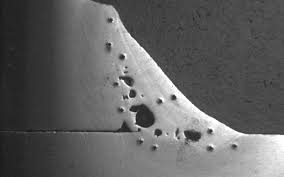Discover What is Porosity in Welding and Its Effect on Architectural Honesty
Discover What is Porosity in Welding and Its Effect on Architectural Honesty
Blog Article
Untangling the Enigma of Porosity in Welding: Tips for Decreasing Problems and Maximizing Quality
In the complex globe of welding, porosity stays a relentless challenge that can considerably impact the top quality and integrity of welded joints. As we delve right into the depths of porosity in welding, discovering the keys to its avoidance and control will certainly be paramount for specialists seeking to grasp the art of top notch weldments.
Understanding Porosity in Welding
Porosity in welding, a typical problem come across by welders, describes the existence of gas pockets or voids in the welded material, which can compromise the honesty and high quality of the weld. These gas pockets are usually trapped during the welding procedure due to numerous variables such as improper securing gas, polluted base materials, or wrong welding parameters. The development of porosity can weaken the weld, making it prone to splitting and corrosion, eventually bring about structural failings.
Recognizing the origin creates of porosity is essential for welders to effectively avoid its incident. By acknowledging the importance of keeping appropriate gas securing, making certain the sanitation of base materials, and enhancing welding settings, welders can substantially reduce the probability of porosity formation. Furthermore, making use of techniques like preheating the base material, using proper welding methods, and carrying out detailed assessments post-welding can better aid in reducing porosity problems. Overall, a thorough understanding of porosity in welding is necessary for welders to create high-grade and long lasting welds.

Typical Reasons of Porosity
When evaluating welding processes for potential top quality issues, recognizing the common causes of porosity is essential for preserving weld integrity and protecting against structural failures. Porosity, characterized by the existence of dental caries or spaces in the weld metal, can significantly jeopardize the mechanical buildings of a bonded joint. One typical reason for porosity is improper shielding gas coverage. Inadequate shielding gas flow rates or inappropriate gas mixes can bring about climatic contamination, leading to porosity development.
In addition, welding at inappropriate specifications, such as exceedingly high travel speeds or currents, can produce excessive disturbance in the weld pool, capturing gases and causing porosity. By dealing with these common causes via correct gas protecting, product prep work, and adherence to ideal welding criteria, welders can lessen porosity and enhance the high quality of their welds.
Techniques for Porosity Avoidance
Executing efficient safety nets is vital in minimizing the event of porosity in welding processes. One strategy for porosity prevention is making certain proper cleaning of the base metal before welding. Impurities such as oil, oil, corrosion, and paint can cause porosity, so extensive cleaning utilizing proper solvents or mechanical techniques is essential.

Making use of high-grade filler products and shielding gases that are suitable for the base metal and welding procedure can significantly reduce the danger of porosity. In addition, preserving proper welding specifications, such as voltage, present, take a trip rate, and gas circulation rate, is vital for porosity avoidance.
Additionally, employing proper welding techniques, such as preserving a consistent traveling speed, electrode angle, and arc length, can assist prevent porosity (What is Porosity). Appropriate training of welders to guarantee they adhere to finest techniques and quality assurance treatments is also essential in reducing porosity issues in welding

Best Practices for High Quality Welds
Ensuring adherence to sector standards and correct weld joint preparation are fundamental elements of attaining continually high-quality welds. In enhancement to these fundamental actions, there are numerous finest methods that welders can carry out to further boost the high quality pop over to this web-site of their welds. One secret technique is keeping correct cleanliness in the welding location. Pollutants such as oil, grease, rust, and paint can adversely impact the top quality of the weld, bring about flaws. Completely cleaning blog the workpiece and surrounding location prior to welding can help minimize these issues.
Another ideal method is to carefully choose the appropriate welding specifications for the certain materials being signed up with. Appropriate parameter selection ensures ideal weld infiltration, blend, and total top quality. Using top quality welding consumables, such as electrodes and filler steels, can dramatically impact the last weld high quality.
Value of Porosity Control
Porosity control plays a critical function in ensuring the stability and quality of welding joints. Porosity, defined by the visibility of dental caries or voids within the weld metal, can dramatically jeopardize the mechanical buildings and architectural honesty of the weld. Too much porosity compromises the weld, making it extra prone to cracking, corrosion, and overall failure under functional loads.
Effective porosity control is essential for preserving the wanted mechanical homes, such as strength, ductility, and toughness, of the bonded joint. What is Porosity. By decreasing porosity, welders can enhance the overall quality and integrity of the weld, making certain that it fulfills the efficiency requirements of the intended application
Furthermore, porosity control is important for achieving the preferred visual appearance of the weld. Excessive porosity not only damages the weld yet additionally takes away from its aesthetic allure, which can be crucial in industries where appearances are very important. Appropriate porosity control strategies, such as making use of the proper protecting gas, managing the welding parameters, and making certain appropriate cleanliness of the base products, are vital for creating high-quality welds with very little flaws.

Verdict
In final thought, porosity in welding is an usual problem Get More Info that can compromise the high quality of the weld. By understanding the root causes of porosity and carrying out proper avoidance strategies, welders can minimize flaws and accomplish better welds. It is important to manage porosity in welding to make sure the stability and stamina of the end product. Applying ideal techniques for porosity control is vital for achieving optimum welding results.
Report this page